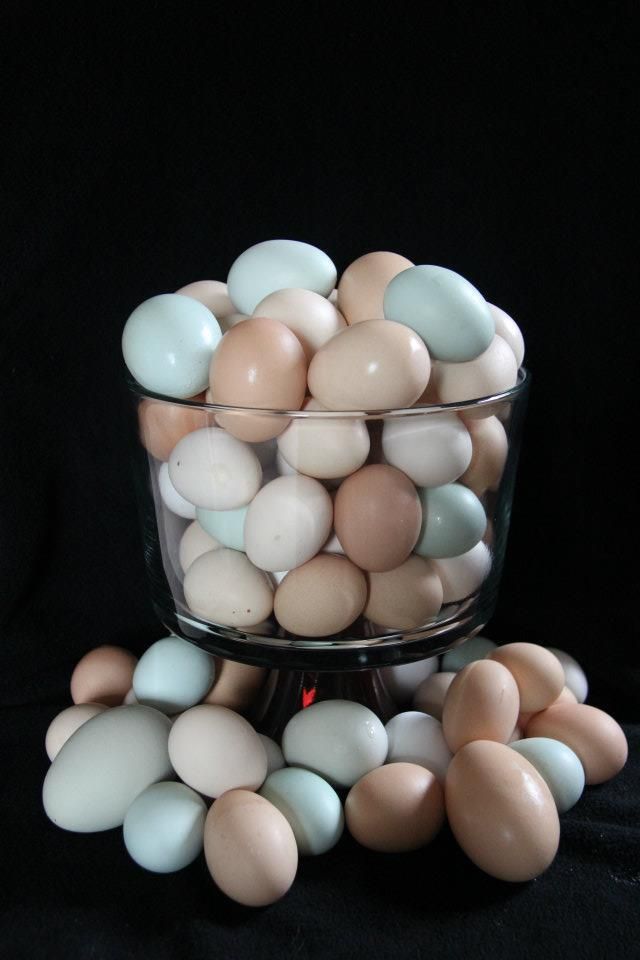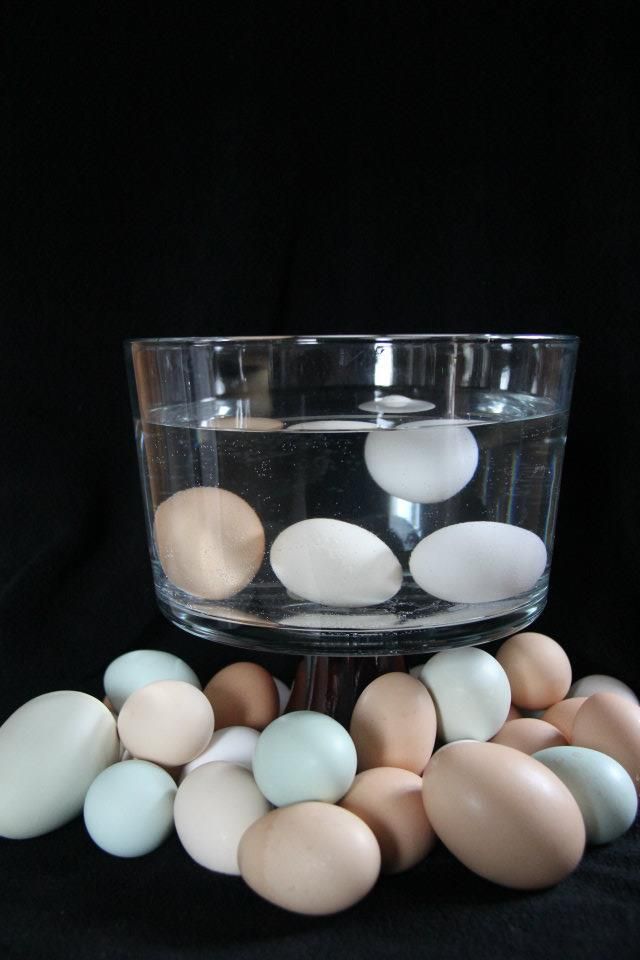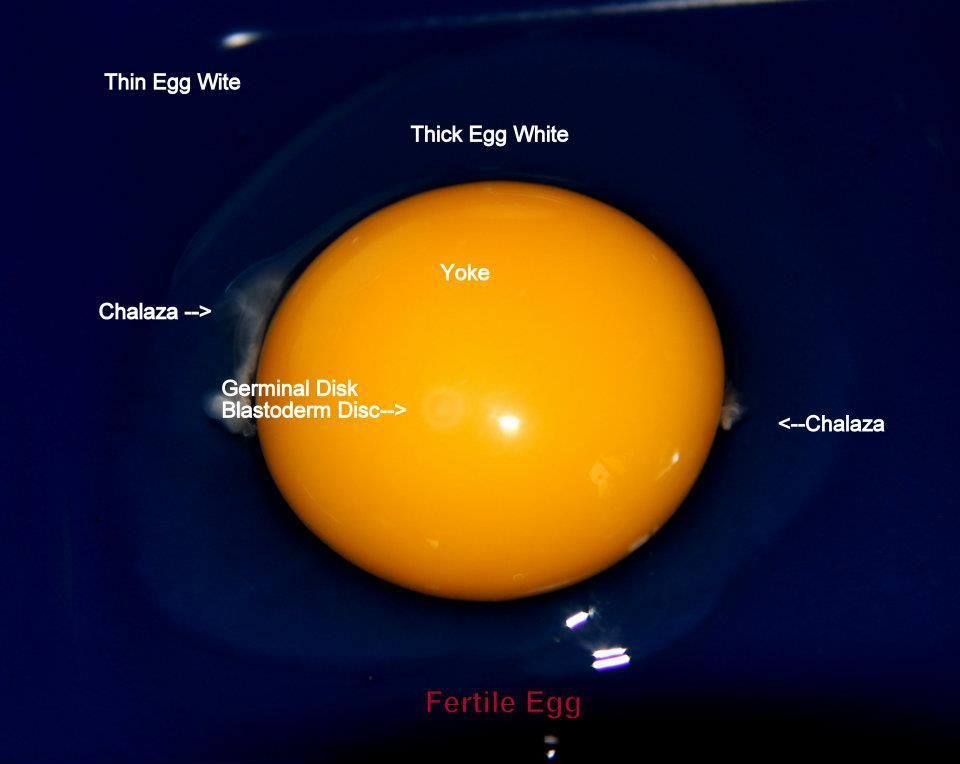So you notice that the egg production has dropped way down and your wondering what the heck is going on. Then you move something in the barn or hen house and there is a nice big mountain of eggs, and it dawns on you... Those sneaky hens are hiding the eggs! Or maybe like me, you keep a bowl of eggs in the fridge and add the small little ones that are for personal use to it daily. But once in a while you get so many eggs it's hard to keep up on the use of them.
Then you're left wondering just how fresh some of those eggs are. Yes, you could toss them. But why toss the good ones along with the bad. Most of the time, even our 'old' eggs are fresher then the ones you are buying off the self in the grocery store.
Heck, you could even test it out on your store bought eggs if you are wondering just how fresh those babies are. Have you ever used store bought eggs and went to boil them and seen them floating and bobbing around in the pot.
Fill a container up with warm water. I use warm water. The reason for this is. Eggs are porous. If you put an egg in cold water, it will contract and draw any bacteria that is on the outside of the shell in through the pores. This is not good. So, if you use warm water, the egg will expand, and you will notice that little air bubbles form on the shell.
Put your eggs into the warm water, and look at them. A very fresh egg will sink to the bottom and lay on it's side. Week old eggs will rest on the bottom but the fat end of the egg will rise up slightly. Three week old eggs will be balanced on pointy end with the fat end sticking up. Old eggs will be floating, bobbing along the surface of the water. These floaters should be tossed as they aren't any good to eat. Or if you have chickens just cook 'em up and feed them back to the chickens.
As eggs age, the air cell in the fat end gets bigger as moisture evaporates from the egg and the air cell increases, causing the egg to float.
You can see the difference a little better in this container.
Another way to tell if your egg is fresh is to crack it and have a look. With a very fresh egg, the white will have a cloudy look to it. This is cause by carbon dioxide still in the egg present when the egg is laid. As the egg ages it will become clear. A fresh egg will have more thick egg white with a bit of the thin. As the egg ages the thick egg white will break down and become thinner. A fresh egg will have lots of nice firm egg white and the yoke will be siting nice and high and round. The yoke will also sort of break down too, and become less firm, breaking when it hits the pan.
Yet another indicator is the Chalaza in the egg. This is those little squiggly white things in the egg that often get mistaken for a partially formed chick or something left over from the rooster. The Chalaza is actually like a twisted springy anchor that holds the yoke safe in the middle of the egg. It is attached to the outer layers of the egg and when you crack that egg, it springs in close to the yoke. These are not harmful to eat at all. As the egg ages, the Chalaza breaks down and in old eggs it will barely be visible. If you hold an old egg up to a flash light in a darkened room you would notice that the yoke will float around more inside the egg if you move the egg around. This is because the Chalaza is breaking down.
Sometimes when you crack an egg, you will find a blood spot or a little piece of something that looks like meat. These are not harmful either, and the egg can still be eaten. You could just scoop out that spot with a spoon. This happens when the egg is being formed and a blood vessel breaks. The meat spot is what happens when the blood clots. It does not mean that the egg is fertilized or is a chick forming.
So, maybe you are wondering just how you will be able to tell if that egg you are about to eat is fertile? Or maybe you want to incubate some eggs and what to figure it out without firing up the incubator to test a few.
Well, on the egg is a spot called a Germinal Disc. If the egg is not fertilized, it is called a Blastodisc. The spot will be small and unevenly shaped.
If the egg is fertile, the Germinal Disc is called a Blastoderm. It will be round in shape and sort of look like a ring.
And there you have it!





hey thats good info even for a nonchicken virgin like myself!
ReplyDeleteThanks silkie...
Thanks, Tabitha! It was fun taking the pictures. Funny how much the roosters get blamed for quirks in eggs. Poor boys!
ReplyDeleteWow, you never know what you don't know until you realize you don't know it.. I learned something new today. Thank you
ReplyDeleteHi Jen,
ReplyDeleteI’m writing on behalf of a shopping mall in Singapore. We’re planning on running a few Lifehack posts in November on our Facebook page.
Facebook: https://www.facebook.com/PlazaSingapura
I really like this neat trick and was wondering if we could possibly feature this idea of yours and use one of your photos (http://i1128.photobucket.com/albums/m490/Silkiebantam/Facebook/Usk%202012%20%20March/523995_10150960584465884_779781838_n.jpg)?
We would provide credit of course, as well as a link to your blog.
Here is what it would look like on our page: https://www.facebook.com/PlazaSingapura/photos/pb.186765461392587.-2207520000.1445335715./867554299980363/?type=3&theater
Do let me know if that would be alright? Look forward to hearing from you!
Thank you.
Elly
Stuff of eggs is almost same all eggs place in every check www.howtly.com/tell-if-eggs-are-bad/- howtly for more info So keep up the wonderful work.
ReplyDelete